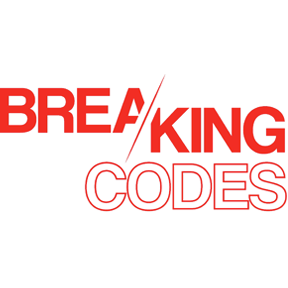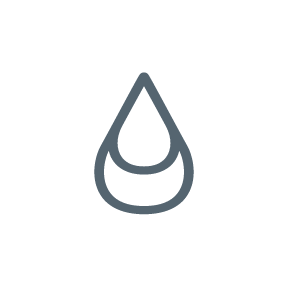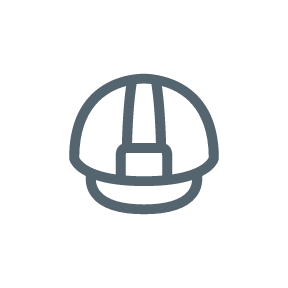INDIVIDUAL PROTECTIVE EQUIPMENT – STANDARDS
In general, the entire body can and should be protected when carrying out work.
Depending on the country in question, legislation may require PPE for specific activities, namely at work, and prescribe :
- wearing a hard hat, helmet and visor on worksites and in certain plants;
- wearing safety shoes on worksites and in certain industries;
- wearing protective clothing (high-neck jacket with long sleeves with fitted sleeve cuffs, long trousers), and possibly gloves, eyewear and masks :
¤ to protect against chemical or biological products;
¤ against heat and fire hazards;
¤ against risk of cuts or wounds (abrasion, bulletproof vest);
¤ that are high visibility to avoid being hit by a vehicle or handling machinery; such as a high visibility vest,
¤ …
- ear protection against noise;
- respiratory protection: insulating or filtering respiratory device (FFP protective masks)
- harness and safety line (rope): protection against falling from a height;
- …
For protection to be effective, PPE must be worn.
This means that users should be able to tolerate wearing such equipment and that it does not interfere with their ability to carry out their tasks.
To ensure that users are better protected, they must be made aware of the importance of wearing protective equipment through training on wearing these devices and on the risks that they encounter when carrying out their job.
Definition of PPE given by the French Labour Law (pursuant to Article R. 233-83-3 of the Labour Law*): « Personal protective equipment (PPE) is a device or means designed to be worn or held by an individual to protect them against one or more health and safety hazards.»
*Annexe 8: Article L 233 – 83 – 3 of the French Labour Law
Directives – European standards
Two directives were established by the European Committee for Standardization (CEN) to set out the rules concerning workers’ health and safety:
– Directive 89/686/EEC*: this directive lays down the rules on product design and the criteria and procedures for putting personal protection equipment (PPE) on the European market for manufacturers.
– Directive 89/656/EEC**: on the use of products, sets out the general rules and responsibilities on selecting and using PPE in the workplace. This directive applies to employees.
In France, these two directives have been adopted and transcribed by decrees and articles of the labour law.
For PPE clothing manufacturers, there are special specifications that must be adhered to when designing PPE: standards.
PPE classification
European Directive 89/686 defines three categories of PPE:
- Category 1 : minor risks: these are products of simple design that provide protection against risks which have no effect on the user’s health, or produce effects that are easily reversible. Marking: This equipment must bear the CE marking.
- Category 2 : moderate risks: This equipment protects against moderate risks that may cause irreversible injury. Marking: These products must bear both the CE marking and the year of manufacture.
- Category 3 : mortal dangers and disability risks: The third PPE category pertains to equipment that provides protection against mortal dangers, such as falling from a height. Marking: This equipment must bear the CE marking with the year of manufacture and the number of the accredited laboratory.
Molinel’s expertise applied to benefit workers’ protection
As workers’ safety is a prime concern, Molinel develops clothing designed to provide optimum protection for workers. From ergonomics to resistance, materials to standards, nothing is left to chance when creating the most suitable outfit for the job to protect against the specific risks that the worker may encounter.

EN 343:2003+A1:2007 standard: PROTECTION AGAINST RAIN
PPE category 1: low risk
This standard specifies the features of clothing to protect against bad weather conditions in temperatures higher than -5°C.
Two essential features must be present in this standard: a garment’s resistance to water penetration and its water vapour resistance (degree of the garment’s breathability).
Resistance to water penetration is the most important quality and it is tested on the outer layer of the garment.
Three performance levels or classes are defined for each feature (class 3 being the most effective).
EN 14058:2004 STANDARD: PROTECTION AGAINST COOL ENVIRONMENTS
PPE category 2
In many cases, simple clothing items are marketed to protect the body against localised sensations of cold.
They may provide a certain degree of protection for a while in moderately cold conditions, depending on factors such as the physical constitution and activity of the wearer, additional clothing and environmental conditions.
Cool environments are characterised by a possible combination of humid and windy conditions at temperatures of -5°C and higher.
Therefore, this standard specifies the requirements and performance test methods for simple clothing items to protect the body against moderately cold environments.
NB: Clothing containing materials with thermal resistance above 0.25m² K/W are designed for cold environments (EN 342 standard).

EN 13034 +A1 – 2009 standard (type 6): Limited protection against chemical splashes
PPE category 3: high risk
This European standard specifies the minimum requirements for limited-use or re-usable chemical protective clothing offering limited protection.
Limited-use chemical protective clothing is designed to be used in the event of likely exposure to small sprays, liquid or low-pressure aerosols, or small splashes, for which a full protective barrier against the permeation of chemicals (at molecule level) is not required.

EN 14404:2004+A1:2010 standard: KNEE PROTECTION
PPE category 2: moderate risk
Kneeling is not a natural working position.
Without knee protectors, workers may suffer discomfort and immediate injury caused by hard surfaces, small stones or similar objects lying on surfaces.
Working in a kneeling position may cause conditions such as infrapatellar bursitis or injury to the knee cartilage, due to continuous pressure on the knees.
Workers in a kneeling position may also be exposed to corrosive and toxic substances. In this case, they must wear trousers and knee protectors that are suitable for this situation and they must be provided with adequate protection
Specific protection is recommended for all work undertaken in a kneeling position.
This standard therefore specifies the requirements relating to work performed in a kneeling position.
There are two types of protection:
- Type 1 : Protectors for knees that are independent of all clothing and are fixed around the leg
- Type 2 : Plastic foam or other padding inserted into pockets on trouser legs or fixed permanently to the trousers
The performance level of these protectors is assessed as follows : (performance levels are defined by the degree of test conditions)
- Level 0: Flat surfaces – no resistance to penetration is required
- Level 1 : Knee protectors suitable for use on flat surfaces where objects more than 1cm high are not a common danger
- Level 2 : Knee protectors suitable for use in difficult conditions, such as kneeling on broken rocks in mines and quarries
This standard provides effective protection for work performed in a kneeling position. Nevertheless, no knee protectors can guarantee that workers will not suffer from medical complications if they remain in a kneeling position over extended periods of time.

EN 11611 standard: Protective clothing for use in welding and allied processes
PPE category 2: moderate risk
This standard specifies the basic safety requirements and test methods for protective clothing […] designed to protect the wearer’s body including head (hoods) and feet (gaiters) and that are to be worn during welding and allied processes with comparable risks […].
This type of protective clothing is intended to protect the wearer against:
• spatter (small splashes of molten metal);
• short contact time with flame;
• radiant heat from an arc flash;
• and minimises the possibility of electrical shock by short-term, accidental contact with live electrical conductors at voltages up to approximately 100 V in normal conditions of welding.
This standard specifies two classes with performance requirements.

EN 11612 standard: Clothing to protect against heat and flame
PPE category 2: moderate risk
The performance requirements set out in ISO 11612:2016 apply to garments which could be worn for a wide range of end uses, where there is a need for clothing with limited flame spread properties and where the user can be exposed to radiant or convective or contact heat or to molten metal splashes.
There are three performance levels for the hazards listed under this standard (1: low to 3: high)
Understanding a pictogram: Example: EN 11612 (A, B1, C1, X, X)
1: Limited flame spread (A)
2: Convective heat (from B1 to B3) – In accordance with EN 367
3: Radiant heat (from C1 to C4) – In accordance with EN 366
4: Spatter of molten aluminium (from D1 to D3, X = not tested) – In accordance with EN 373
5: Spatter of molten cast iron (from E1 to E3 X = not tested) – In accordance with EN 373
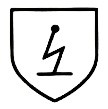
EN 1149-5 standard: Protective clothing with antistatic characteristics
PPE category 2: moderate risk
This standard ensures that electric energy is dissipated through the clothing and prevents sparks that may cause a fire outbreak.
Warning: these requirements are not enough to provide protection in oxygen-rich, flammable areas, or against line voltages.
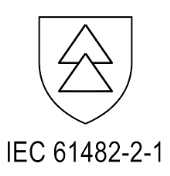
IEC 61482 standard: Clothing to protect against thermal hazards of an arc flash
This standard includes requirements and testing methods for materials and garments used for protective clothing for electricians to protect against the thermal hazards of an arc flash, which are based on:
• the general characteristics of the fabrics
• the properties of thermal resistance to an arc flash
The requirements of this standard do not cover the hazard of electric shock, the effects of noise, UV emissions, metal fragments, or toxic influences.
What is an arc flash?
An arc flash is a flash of light or heat that occurs in an electrical system as the result of a fault (such as a short circuit).
This electrical discharge between two conducting electrodes:
• surges momentarily (0.5 to 1 sec; rarely >1s).
• generates extremely high radiant heat (1,000 to 10,000°C)
• vaporises metal and spatters metal fragments
• generates sound that can reach 165 dB

EN 812 standard
The EN 812:A1 standard relates to common-use bump caps (anti-scalping). These are used in industry to protect the wearer’s head from impact with hard and static objects that may knock them unconscious or cause lacerations and superficial injuries.
These caps are generally designed for indoor use but can also be used outdoors for certain professions.
A shock-proof cap is not intended to provide protection against the impact of falling objects and should not replace a protective hard hat for use in industrial applications under any circumstances, in accordance with the EN 397 standard.
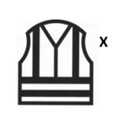
EN 20471 standard: High visibility signal clothing
PPE category 2: moderate risk
EN ISO 20471 specifies the requirements for clothing designed to visually signal the user’s presence (as of 1 October 2013, this standard replaces the EN 471: 2003 + A1 2007 standard). This clothing is intended to make the wearer more easily visible to drivers of vehicles or other mechanised equipment, in any light conditions, be it day or night, under illumination of the vehicle’s headlights.
Users must consider the surrounding environment when determining the necessary protection, and consequently choose a colour that ensures the most contrast.
When greater visibility is required, retroreflective products with the highest coefficient of retroreflection should be used.
There are three classes of signal clothing:
– Class 1: for clothing with the lowest level of visibility
– Class 2: for clothing with a moderate level of visibility
– Class 3: for clothing with the highest level of visibility
Each class stipulates the minimum surface areas on the clothing that must be made of visible material: main material (fluorescent) and retroreflective material (bands) – see table below.
Minimum visible surface areas for each material in m²:
| Class 1 | Class 2 | Class 3 | |
| Fluorescent material | 0.14 m² | 0.50 m² | 0.80 m² |
| Retroreflective material | 0.10 m² | 0.13 m² | 0.20 m² |
Design requirements illustrating how this retroreflective material should be arranged are also stipulated under this standard.
All sides of the garment must be made of high visibility material. To ensure visibility from all sides (360° visibility), horizontal retroreflective bands and fluorescent material should surround the torso, trouser legs and sleeves.

